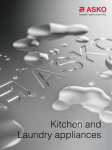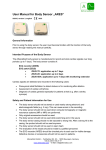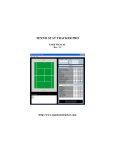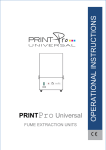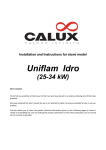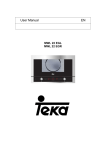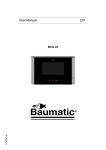Download Operating instructions CC4520
Transcript
Operating instructions CC4520 3LIK1224 700004897000 You will find the addresses and phone numbers of the service organisation on the guarantee card. EN Manual Pictograms used Important information Tip EN 3 - EN 14 CONTENTS Your canopy hood Description Introduction 4 4 Precautions you must take Extraction systems 5 6 Controls 7 Cleaning Grease filters Carbon filter Lighting 8 9 9 9 General Electrical connection Assembly 10 11 12 Disposal 13 Safety Use Maintenance Installation Appendix EN 3 YOUR CANOPY HOOD Description A B C D E F Lighting Switch off Fan position 1 Fan position 2 Fan position 3 Timer Introduction This user manual gives you a quick overview of all the possibilities offered by the appliance. You will find information on safety measures and maintaining the appliance. Please retain this user manual and the installation guide. They may be of use to future users of the appliance. EN 4 SAFETY Precautions you must take Make sure the appliance is installed by an authorised installer (see "Installation" chapter). Do not connect the appliance to the mains before completing the installation. • Connect the appliance in accordance with the applicable regulations in your area. • We advise you to wear protective work gloves during the installation of the cooker hood because of possible sharp edges. • The appliance has been manufactured in accordance with the latest safety standards. However we do advise that persons with a mental or motor impairment do not use this appliance without the proper supervision of a competent person. The same applies to children. • Never use the cooker hood if the grease filter has not been properly installed! • Do not lean against the cooker hood. • Never place objects on the hood unless specifically indicated. • Make sure there is sufficient ventilation when you use the cooker hood on a gas cooker. • The exhaust must never be connected to a flue that is also used for other heating appliances. • Never flambé under the cooker hood and always clean the filters promptly. Never leave frying pans unattended during use, as the heated fat may catch fire. • The cooker hood needs to be cleaned regularly (at least once a month) on the inside as well as on the outside. Insufficient cleaning or late replacement of filters may pose a fire hazard. • If the connection cable becomes damaged, it should be replaced by the manufacturer’s service department or by a person with equivalent qualifications, in order to prevent dangerous situations from arising. • Attention! Intensive use may cause condensation to form on the cooker hood. Condensation can be removed easily with a dry cloth. EN 5 SAFETY Precautions you must take • When replacing the lights, first disconnect the appliance from the mains! Only use identical lamps with the wattage indicated. Only use the cooker hood with lamps installed, in order to reduce the risk of electric shock. • Accessible parts may become hot when used with cooking appliances. • The grease filters become hot during operation. Wait a minimum of 30 minutes after cooking before cleaning the filters. • The power must be switched off during repairs or cleaning. Remove the plug from the mains socket or turn the switch in the meter cupboard to zero. • Grease and oil are flammable when they are overheated. Stay in the vicinity of the cooker when preparing food. • We will not accept any responsibility for any faults, damage to the appliance, or fires resulting from non-observance of the instructions included in this manual. Extraction systems Depending on the type, the cooker hoods can be connected in one of two ways: 1. To a duct. The cooking vapours extracted by suction are carried outside, once the grease particles have been filtered. This is the best method. 2. Recirculation hood. When the hood is connected as a recirculation hood, the grease particles and odour in the extracted vapours are filtered. The extracted air is not carried outside but recirculates in the kitchen. In this case you must have a carbon filter fitted. Attention! The carbon filter needs to be ordered separately. EN 6 USE Controls Switching fan on and off Press the speed button C, D or E The extractor hood switches on in the corresponding position. Press the off button B. The fan will switch off. Switching lighting on and off Press the lighting button A. The lighting switches on. Press the lighting button A again. The lighting switches off. Timer Press the F button The timer is switched on. The extractor hood remains switched on in this setting for 15 minutes. After that, the extractor hood switches off. Press the F button again. The timer is switched off. EN 7 MAINTENANCE Cleaning Attention! Before performing any maintenance operation, isolate the hood from the electrical supply by unplugging the appliance or switching off your household’s master switch. The cooker hood should be cleaned regularly (at least as frequently as the grease filters are cleaned) both internally and externally. Do not use abrasive products. Do not use alcohol! Attention! Failure to comply with the basic recommendations for cleaning the cooker hood and cleaning/replacing the filters may lead to a fire. Therefore, we recommend that you observe these instructions. The manufacturer declines all responsibility for any damage to the motor or any fire damage linked to inappropriate maintenance or failure to observe the above safety recommendations. Cooker hood Clean the cooker hood with soapy water and a soft cloth. Then wipe with clean water to rinse. Do not apply aggressive cleaning agents such as caustic soda. The paintwork on the cooker hood will remain shiny if it is periodically rubbed with wax. Stainless steel canopy hoods Do not use any sort of scourer. Treat with a stainless steel care product and polish with the structure of the stainless steel. Metal grease filters These must be cleaned once a month (or when indicated by the filter saturation indication system, if present on your model) using nonaggressive detergents, either by hand or in the dishwasher, which must be set to a low temperature and a short cycle. The openings must be placed downwards to let the water run out of the filters. When washed in a dishwasher, aluminium grease filters may be discoloured slightly. This is normal and does not affect their filtering capacity. EN 8 MAINTENANCE Grease filters Removing the grease filters • Move lock ‘C’ in a downward direction and remove filter ‘G’ from the hood. Carbon filter Replacing the carbon filter The carbon filter must always be used if the cooker hood is not ducted. 1. Remove the grease filters ‘G’. 2. Attach the carbon filters ‘J’ by hooking the brackets ‘K’ in the openings. 3. Replace the grease filters ‘G’. Note: • Saturation of the activated charcoal will eventually occur after prolonged use, depending on the type of cooking and how frequently the grease filter is cleaned. • The carbon filter needs to be replaced at least every four months. • The carbon filter cannot be washed for reuse. Saturated carbon is not environmentally friendly. Change the filter regularly. Lighting Changing the light bulbs • Remove the lamp cover. • Replace the halogen light bulb with a replacement bulb with a maximum output power of 20 Watts. • Re-close the lamp cover. EN 9 INSTALLATION General This appliance must be connected to the electric mains by an authorised installer who is familiar with the safety precautions and will carry them out. The appliance is in compliance with European guidelines. Important information: • The distance between the lowest point of the cooker hood and a hob must be at least 65 cm. • If the cooker hood is connected to an existing exhaust duct, no other appliance must be connected to the duct (such as a hot water heater or a stove). • Consider local regulations with respect to the ventilation of gas appliances. • The shorter the duct, and the fewer bends in it, the better the cooker hood will work. • Check before you start drilling that no installation pipe(s) is/are present. • The connection pipe to the cooker hood has a diameter of 150 mm. We recommend that the exhaust pipe has as large a diameter as possible. • The enclosed installation materials are suitable for reinforced concrete and brick walls. For some types of wall you may need special plugs and screws. EN 10 INSTALLATION Connection Electric connection The appliance has been manufactured as a class II, therefore no earth cable is necessary. Make sure the supply voltage ratings correspond with those stated on the appliance data plate. The connection to the mains is carried out as follows: BROWN = phase L BLUE = phase N This canopy hood has been provided with a power plug. When installing the hood, make sure that this plug remains accessible. We recommend installing the wall socket out of view, behind the chimney cover. Attention! If you are making a fixed connection, you must ensure that a double pole switch with an air gap of at least 3 mm is fitted in the supply line. max 90 cm EN 11 INSTALLATION Building in dimensions Assembly • Remove the grease filters. • Make an opening underneath one of the kitchen cupboards. Check the dimensions on the installation drawing. • Screw the hood into the kitchen cabinet with 4 screws. EN 12 APPENDIX Disposal Disposal of appliance and packaging This appliance was manufactured using sustainable materials. It must be disposed of responsibly at the end of its life cycle. The local authorities can provide you with the relevant information. The packaging of this appliance is recyclable. It may have been made from: • cardboard; • polythene film (PE); • CFRP-free polystyrene (PS hard foam). You need to dispose of these materials responsibly in accordance with official regulations. To draw attention to the fact that the segregated processing of household electrical appliances is compulsory, this appliance carries the symbol of a crossed-out dustbin. This means that you may not dispose of the appliance as household refuse at the end of its useful life. Instead, it should be taken to a special segregated refuse collection centre run by the local authority or to a dealer providing this service. Segregated processing of household appliances prevents any negative impact on the environment and public health that might otherwise arise. It allows the recovery of the materials used to manufacture this appliance, thus generating considerable savings in terms of raw materials and energy. Declaration of conformity We declare that our products meet the applicable European Directives, Decisions and Regulations and the requirements listed in the standards referenced. EN 13 EN 14














